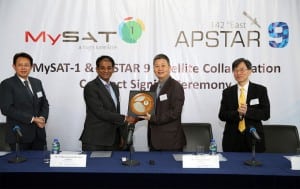TSGN CEO Bullish on ASEAN Satcom Demand

From left: Kent Ho, group CEO of TSGN; T. Dhrmarajah Dhashna, group managing director of TSGN; Cheng Guangren, director and president of APT; Lo Kin Hang, VP and company secretary of APT.
Photo: APT
[Via Satellite 06-17-2015] TS Global Network (TSGN), a privately owned satellite telecommunications company in Malaysia, recently teamed up with Hong Kong-based APT Satellite to have a major presence on Apstar 9. The company procured a significant amount of C-band capacity to provide services to customers across the Association of South East Asian Nations (ASEAN) region.
TSGN Group CEO Kent Ho told Via Satellite that the MySat 1 designated payload gives TSGN room to finally rollout specialized services using a payload tailored for its target market. The company has more than 150 Malaysian corporations and multinational companies as customers spread across Malaysia, Indonesia and Brunei. The capacity provides space segment room to grow for existing customers, provides room for new customers and helps expand TSGN’s regional presence.
“Our existing clients will account for 50 percent of the capacity of MySat 1 while the rest will be used for new customer acquisition,” Ho explained. “We are primarily targeting the ASEAN and Asia-Pacific markets. Aside from increasing our offerings in countries which we are currently present in (Malaysia, Indonesia and Brunei), we are actively in discussion on opportunities in Indochina and Philippines.”
Apstar 9 is a replacement satellite for APT Satellite’s Apstar 9A spacecraft. China Great Wall Industry Corporation is building the satellite with 32 C-band transponders and 14 Ku-band transponders. Scheduled to launch in the fourth quarter of 2015, the satellite will cover much of Asia Pacific from 142 degrees east. APT Satellite declined to participate in this interview.
TSGN has set a goal of doubling regional sales to 20 percent by the year 2020. The effort is spurred by significant infrastructure investments both on its space segment and ground segment. TSGN also provides terrestrial telecommunications services through means such as fiber and microwave. Ho said the company has occasionally used short- to medium-term satcom capacity leases, and now end-of-life payloads on various constellations of regional satellites to meet market needs. These contracts are bound by Non-Disclosure Agreements (NDA). The addition of MySat 1 provides ample growth potential for the company.
“We believe that 20 to 25 percent of all telecommunication networks in the region will ride on satellite directly or indirectly,” said Ho. “Currently, in the operating countries we are in, our total solutions to partners and customers are often hybrid in nature with various last-mile mediums. TSGN continues to source for satellite capacity beyond MySat 1 as we are bullish satcom will grow steadfast alongside fiber and other wireless network.”
TSGN plans to provide satcom solutions to both government and commercial customers through MySat 1. Ho said the payload will also help actively bridge the digital divide through its ability to reach unserved and underserved regions.
Earlier this year TSGN purchased a Hughes Jupiter system to upgrade its C-band satellite network, making TSGN the first operator to use the platform — typically employed for Ka-band High Throughput Satellite (HTS) services — for conventional C band. Hughes is providing a Jupiter Gateway along with enterprise-class broadband satellite terminals to more than 3,000 locations.
Ho said TSG has engineered its latest teleport at Cyberjaya to scale to support various platforms and services, and is in the midst of augmenting other partnered teleports in the region to support uniformed services as well.
“We are constantly looking at next generation ground systems that will make our network solutions more efficient,” he said. Furthermore, TSGN plans to continue building capacity beyond MySat 1 in the future. Asked if he could see TSGN owning a satellite of its own some day, Ho said, “Yes, if the financial attractiveness, specific performance/features and target market requirements are aligned.”
This article was updated at 9:00 ET on June 18, 2015.